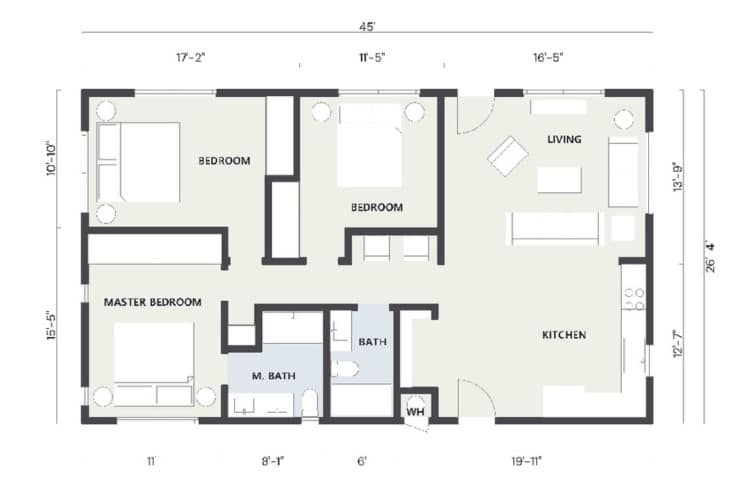Solar Panels for ADU: Requirements, Costs & Benefits in San Diego
17 min read
As San Diego homeowners embrace Accessory Dwelling Units (ADUs), integrating solar panels has become a smart way to enhance sustainability, reduce energy costs, and boost property value. In this blog, we explore the role of solar in ADU development, covering essential requirements, costs, and long-term benefits for homeowners.

What is the Role of Solar in San Diego ADU Development?
Accessory Dwelling Units (ADUs), small secondary housing units, are ideally suited for solar integration due to their compact size and lower energy demands. Solar panels significantly boost ADU efficiency, cost savings, and sustainability.
California’s Title 24 energy standards explicitly require solar installations for most newly built, detached ADUs to advance statewide renewable energy goals. The California Housing and Community Development (HCD) confirms that “newly constructed, non-manufactured, detached ADUs are subject to the Energy Code requirement to provide solar panels” (HCD ADU Handbook, 2020).
San Diego homeowners especially benefit from solar due to the region’s high electricity costs and abundant sunlight, making solar energy exceptionally cost-effective. Local and federal incentives, such as the 30% Federal Residential Clean Energy Credit, further improve the return on investment. Additionally, homes with solar installations sell for about 4.1% more than comparable properties without solar, according to Zillow research.
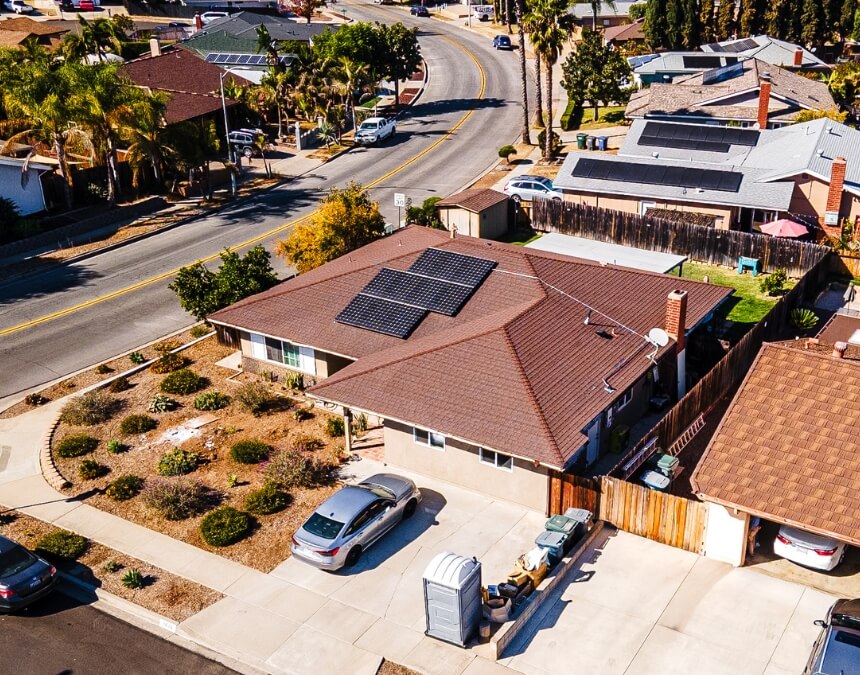
San Diego’s abundant sunlight and high utility rates make solar integration an essential first step in maximizing ADU efficiency and ROI.
Why Integrate Solar Panels in ADUs?
Integrating solar panels into your Accessory Dwelling Unit (ADU) is an investment that offers multiple substantial benefits. Solar energy systems are not just environmentally friendly—they deliver immediate financial savings, enhance your property’s resale value, and align your ADU with California’s sustainability mandates and goals. Here’s a closer look at these key advantages:
Long-term Electricity Bill Savings
Solar panels significantly reduce your monthly electricity bills, providing substantial savings over time. According to EnergySage, the initial investment in solar typically pays for itself within approximately 6–8 years. After this period, the energy generated by your solar system is essentially free, dramatically reducing or even eliminating electricity expenses for decades to come. On average, California homeowners save around $50,000 in electricity bills over 25 years by installing solar (EnergySage).
Increase in Property Resale Value
Installing solar panels on your ADU doesn’t just lower energy costs—it also significantly boosts your property’s market value.
What the Data Shows
- Multiple studies and real estate analyses confirm that homes with solar panels generally sell for more than comparable homes without solar.
- The most widely cited figure comes from a 2019 Zillow study, which found that homes with solar-energy systems sold for 4.1% more on average than comparable homes without solar power.
- This 4% premium translates to thousands of dollars in added value; for the median-valued home in the study, this equated to an additional $9,274 in resale value.
- Other authoritative sources, including Lawrence Berkeley National Laboratory and EnergySage, report similar increases ranging typically from 3% to 5% depending on local market conditions.
- In high-demand areas, such as San Diego, these premiums can be even higher, sometimes reaching up to 5–7% or more due to the region’s favorable climate conditions and high electricity rates.
In addition to added property value, homes equipped with solar panels also tend to sell faster. Real estate professionals note that solar installations attract eco-conscious buyers actively seeking energy-efficient and environmentally friendly homes.
Environmental Benefits
Beyond financial incentives, solar panels substantially reduce greenhouse gas emissions, aligning directly with California’s broader environmental objectives. By generating clean, renewable energy directly on-site, solar-powered ADUs significantly decrease their carbon footprint. This contributes positively to statewide sustainability initiatives and helps homeowners actively participate in climate change mitigation efforts.
Compliance with California State Energy Codes
California Title 24 compliance energy standards mandate solar panel installations on most newly constructed, detached ADUs. As stated clearly by the California Energy Commission (CEC), “newly constructed ADUs are subject to the Energy Code requirement to provide solar panels if the unit is a newly constructed, non-manufactured, detached ADU.” By integrating solar panels during the ADU construction process, homeowners ensure compliance, avoid potential penalties, and enhance the property’s overall marketability.
Achieving Energy Independence
Solar-powered ADUs offer homeowners a pathway toward energy independence. By generating their own electricity, ADU owners significantly reduce their reliance on traditional utility providers and insulate themselves from fluctuating electricity prices. Additionally, when combined with battery storage solutions, solar-equipped ADUs become even more resilient, maintaining power during outages and ensuring continuous energy security regardless of external grid conditions.
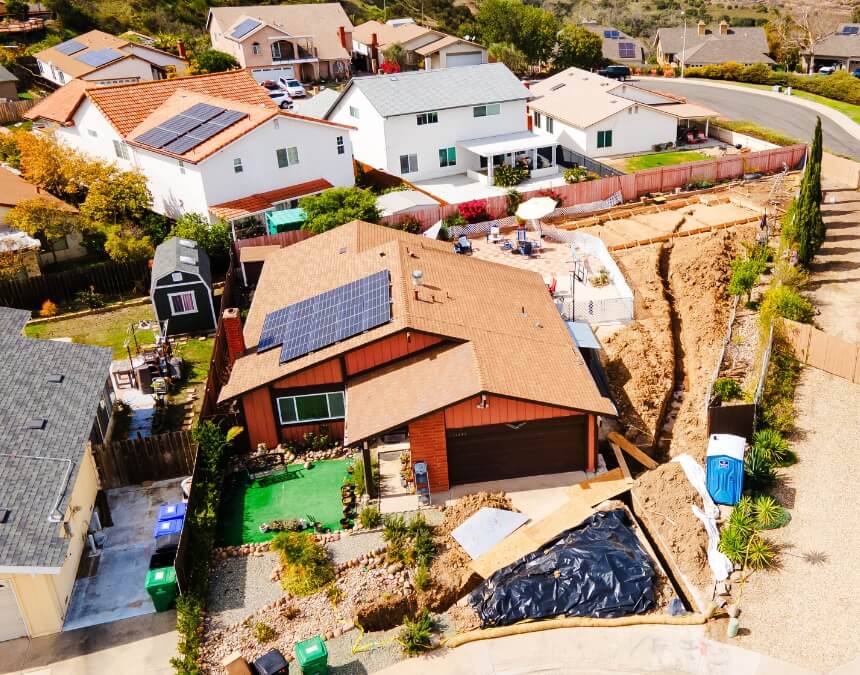
Installing solar during ADU construction yields compounding benefits—energy savings, Title 24 compliance, and long-term property value.
What Are the Costs and Savings of Installing Solar on an ADU?
Investing in solar panels for your Accessory Dwelling Unit (ADU) involves upfront costs but also provides substantial long-term financial benefits. Understanding the typical costs, available incentives, and optimal timing for solar installation can help San Diego homeowners maximize their savings and overall return on investment (ROI).
Typical Initial Investment
According to multiple reputable sources, the typical cost to install a solar panel system on an ADU in California ranges from $12,000 to $18,000. For example, a 2025 industry guide emphasizes that “on average, the cost can range from $12,000 to $18,000, but this investment can be offset by federal tax credits, state incentives, and reduced electricity bills over time.” Another recent overview supports this estimate, noting that homeowners can expect similar investment ranges based on their specific ADU design and household energy usage.
While certain larger or more complex installations may occasionally reach up to $20,000 or $25,000, the most commonly cited range for a standard ADU solar installation in California remains consistently between $12,000 and $18,000.
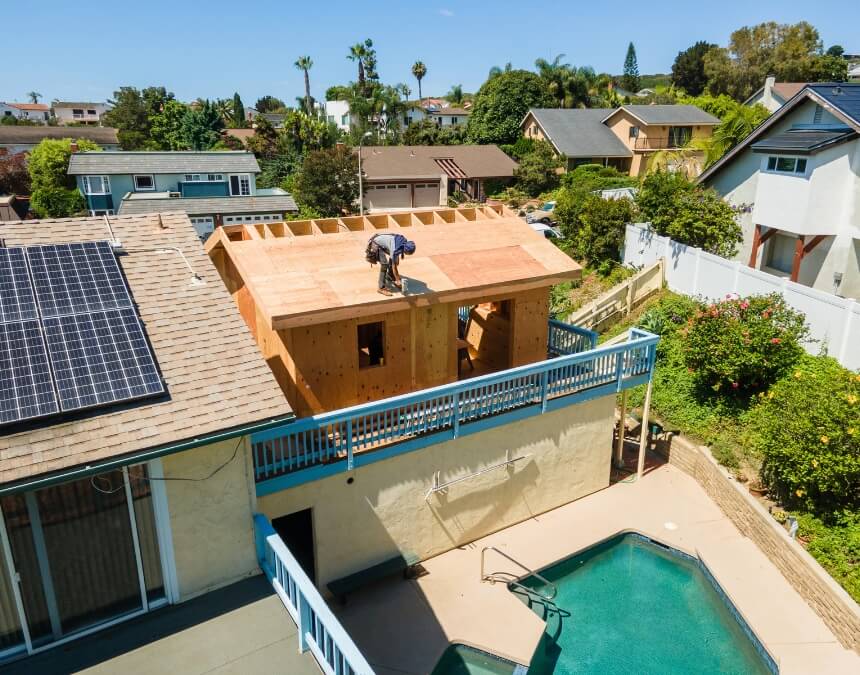
Plan solar during the ADU build to cut retrofitting costs—investing early unlocks tax credits and decades of energy savings.
Federal Incentives: Residential Clean Energy Credit
Significantly reducing the initial cost burden, homeowners installing solar systems are eligible for a federal tax incentive known as the Residential Clean Energy Credit. Currently, this tax credit covers 30% of the total solar installation cost. For example, if your ADU solar installation costs approximately $15,000, you would receive a tax credit of about $4,500, effectively lowering your net cost significantly (EnergySage).
Optimal Integration for Maximum Savings
To further enhance cost efficiency, experts strongly recommend integrating solar installation during the initial ADU construction process. Doing so avoids additional costs associated with retrofitting panels onto completed structures, minimizes logistical complications, and aligns with California’s Title 24 compliance requirements. According to leading local ADU builders, integrating solar at the initial construction phase “requires no additional build time,” making it both cost-effective and efficient.
Summary of Costs and Incentives
| Cost and Savings Factors | Typical Range/Details |
|---|---|
| Initial Investment | $12,000–$18,000 (average) |
| High-end Cost Estimates | Up to $20,000–$25,000 (complex systems) |
| Federal Tax Incentive | 30% Residential Clean Energy Credit |
| Optimal Installation Timing | During initial ADU construction |
| Long-term Savings (25-year estimate) | Approximately $50,000 in electricity bills (EnergySage) |
What are California’s Title 24 Solar Requirements for ADUs?
California’s Title 24 building energy standards mandate solar panels for many newly constructed Accessory Dwelling Units (ADUs). Established by the California Energy Commission (CEC), these regulations aim to reduce energy consumption, encourage renewable energy use, and support the state’s ambitious environmental goals. Understanding when these mandates apply—and when exemptions are possible—is crucial for San Diego homeowners planning an ADU project.
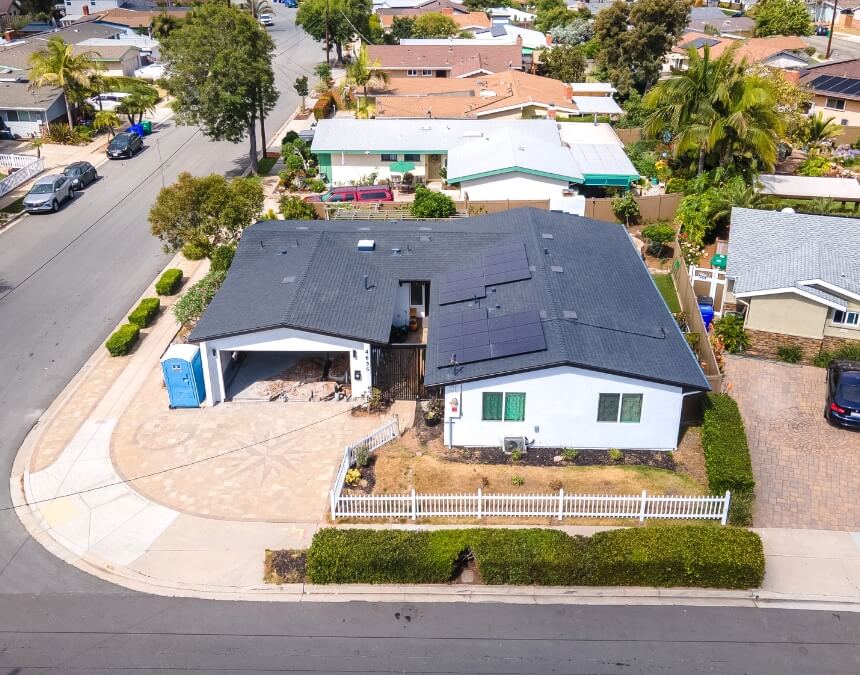
Title 24 mandates solar for most new detached ADUs—consult your builder early to verify exemptions and avoid compliance delays.
When Are Solar Installations Required?
Under Title 24, solar panels are required on new, detached, stick-built ADUs exceeding certain thresholds. Generally, newly constructed detached ADUs larger than 1,125 square feet must include solar installations. However, the requirements become nuanced for smaller ADUs, particularly based on size, climate zone, and calculated system needs.
Key Exemptions to Title 24 Solar Requirements
California’s solar mandates include several important exemptions clearly outlined in the CEC’s Title 24 guidelines. Below are the most common exemption scenarios:
- Conversions and Additions: ADUs created by converting an existing structure, such as a garage or an attached portion of a primary residence, are typically exempt from solar requirements. This exemption applies whether the conversion is attached or detached.
- Manufactured or Prefabricated ADUs: Prefab or manufactured ADUs are regulated under separate codes and are therefore exempt from Title 24’s solar installation requirement.
- Small ADUs (Below 620 sq ft): In many cases, small ADUs under approximately 620 square feet may qualify for exemption, particularly in specific climate zones such as those found in parts of San Diego County. It’s crucial to verify local interpretations of this exemption.
- Solar System Size Below 1.8 kWdc: If the required solar system size, calculated using Title 24’s formula, is under 1.8 kWdc, solar installation becomes unnecessary, irrespective of the ADU’s square footage.
Summary of Title 24 Solar Exemptions
- Jurisdictions might interpret or enforce these exemptions differently. It’s always recommended to confirm specific local requirements with your local San Diego building department.
- The 1.8 kWdc exemption threshold is strictly based on the calculated requirement from Title 24’s formula, not just on the physical size of the ADU.
| Exemption Type | Description/Threshold | Typical Examples |
|---|---|---|
| Conversion/Addition | ADU created within existing structure or attached space | Garage conversions, basement ADUs |
| Manufactured ADU | Prefabricated or modular units | Factory-built modular units |
| Small Unit (by size) | Less than ~620 sq ft, varies by climate zone | Compact, detached backyard ADUs |
| Small PV System Requirement | Calculated system size under 1.8 kWdc | Small or energy-efficient units |
What Are Practical Considerations for Solar-Powered ADUs?
When planning solar integration for an Accessory Dwelling Unit (ADU) in San Diego, homeowners must consider several practical factors to ensure efficiency, compliance, and cost-effectiveness. Beyond initial investment, attention to system sizing, installation timelines, permitting processes, and available tax incentives can significantly impact the success of a solar-powered ADU project.
System Size Requirements
Determining the appropriate solar system size is a critical step that affects both compliance with California’s Title 24 standards and long-term financial benefits. Title 24 specifies a formula-based calculation for minimum photovoltaic (PV) system sizes based on the ADU’s conditioned floor area and location-specific energy needs.
For precise system sizing, homeowners and builders frequently use tools such as the PVWatts Calculator, provided by the National Renewable Energy Laboratory. This calculator helps homeowners determine accurate solar energy generation estimates and corresponding system sizing to satisfy both regulatory requirements and household energy demands.
Installation Options and Timelines
To avoid potential delays, it is essential to understand the typical timeline associated with solar panel installation on ADUs. Generally, the solar installation process occurs in parallel with ADU construction, streamlining the overall timeline.
Installation Timeline (60–90 Days):
According to industry standards and local builder insights, the complete solar installation process, from initial planning to final utility approval, typically ranges between 60 and 90 days. This includes:
- Site assessment and solar system design
- Coordination with utility providers
- Installation of panels and related components
- Final inspections and obtaining permission to operate (PTO)
Once permits are secured, physical installation and utility sign-off usually take only 2–4 weeks, provided there are no unusual delays.
Permitting Timeline (Approximately 45 Days):
The permitting phase specifically often takes around 45 days, though this can vary between 2 to 8 weeks depending on municipal processing times, inspection availability, and completeness of submitted documentation. Some localities offer expedited or “instant” online permitting processes for standard solar installations, significantly reducing this timeframe.
Timeline Summary for Solar Installation on ADUs
|
Step |
Typical Duration |
Notes |
|---|---|---|
|
Permitting |
~45 days |
May vary by jurisdiction; faster online options available |
|
Installation & Build |
60–90 days total |
Includes assessment, installation, and final approval (PTO) |
Navigating Potential Tax Incentives
A critical practical consideration that can significantly reduce upfront costs for homeowners is the federal Residential Clean Energy Credit, which currently provides a 30% tax incentive on solar installation costs.
For example, if your total solar installation cost is $10,000, the federal incentive would offer a tax credit of approximately $3,000, effectively reducing your net investment to just $7,000.
Leveraging these incentives enhances cost efficiency, making solar integration into ADUs not just environmentally beneficial but also financially attractive.
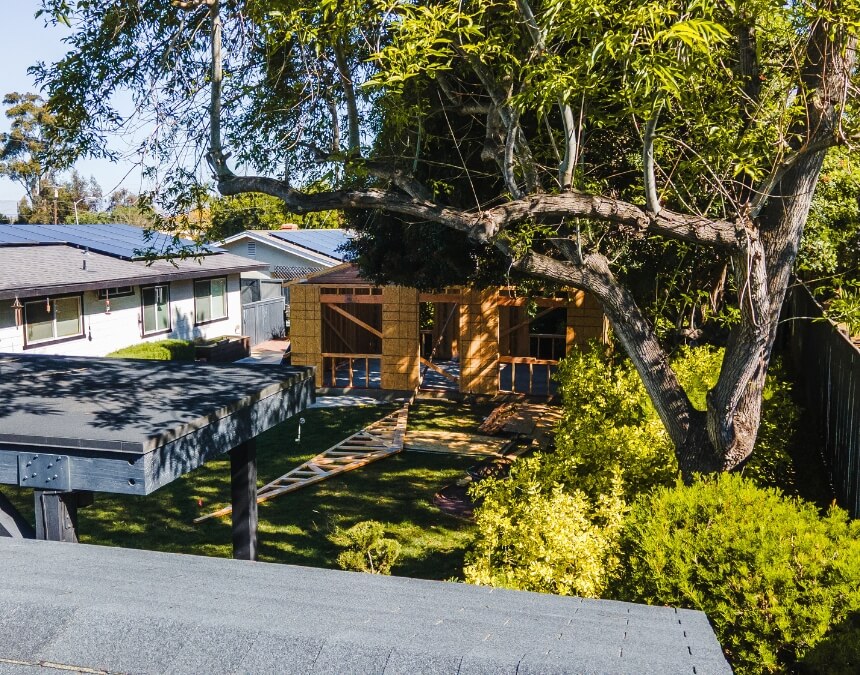
Coordinate solar with utility upgrades and permitting to streamline ADU construction—early planning prevents costly rework.
How Can You Integrate Solar Panels into ADU Construction and Design?
Effectively integrating solar panels into the construction and design of an Accessory Dwelling Unit (ADU) ensures compliance with California’s Title 24 requirements, maximizes energy efficiency, and enhances property aesthetics. By planning for solar integration early, homeowners in San Diego can streamline the construction process, achieve cost savings, and maintain visual harmony between their main residence and ADU.
Coordinating Solar Systems with ADU Electrical Setup
Solar panel systems for ADUs don’t necessarily have to be installed directly on the ADU structure itself. Depending on site layout, roof orientation, and shading factors, panels can be placed on the main home, ground-mounted arrays, or integrated with existing solar installations on the property. This flexibility allows homeowners to optimize solar efficiency and aesthetics simultaneously.
It’s also essential to recognize certain exemptions where solar installations are not required, such as when converting existing spaces (like garages or attached areas) into ADUs or using prefabricated modular units. These situations typically bypass solar mandates, simplifying the electrical planning process (Autonomous.ai).
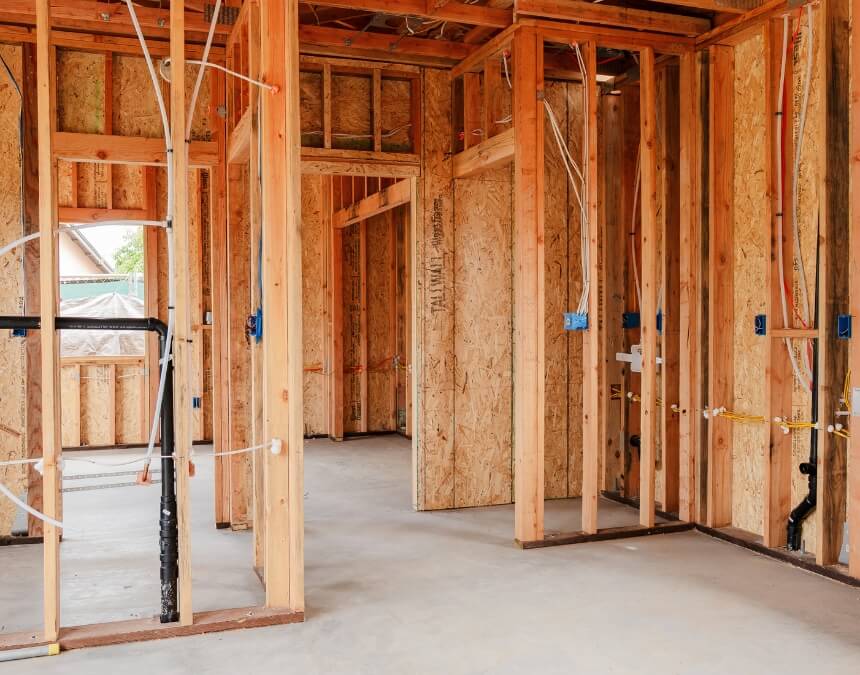
Integrate solar early in the ADU build to avoid retrofitting costs and align your electrical system with Title 24 compliance from day one.
Addressing Construction Timelines
Integrating solar installation from the early planning stages of your ADU construction can lead to significant efficiencies and avoid potential delays. Coordinating the solar permitting process and panel installation simultaneously with general construction activities can streamline timelines, often ensuring that solar readiness coincides seamlessly with final ADU completion. Early integration also helps prevent additional construction costs or logistical issues later in the process.
Seamlessly Integrating Solar in Design
Optimal practices for seamlessly integrating solar panels into your ADU’s design include careful electrical coordination and strategic planning for potential future solar expansions. Ideally, solar system integration should be coordinated with your electrical contractor to ensure compatibility with the main service panels and utility connections. Good design practices also allow future solar expansions to connect to the existing system without requiring separate metering, simplifying ongoing energy management and potentially lowering future costs.
Solar Panel Aesthetics and Home Design Compatibility
A common concern among homeowners considering solar panels is maintaining the visual harmony and overall aesthetic appeal between their ADU and main residence. Choosing visually appealing solar panels that complement existing roof materials, colors, and architectural style is crucial. Many modern solar panels offer sleek designs, various colors (such as black-on-black options), and low-profile mounting solutions.
To preserve design compatibility, homeowners should:
- Select panel colors that closely match or complement roof tones.
- Opt for low-profile panels or integrated solar roof tiles for minimal visual disruption.
- Coordinate the ADU’s architectural style and color palette with the primary residence to ensure consistency across the property.
Grid-Tied vs. Off-Grid Systems for ADUs: What Should You Choose?
When planning solar for your ADU, an important decision involves choosing between a grid-tied system (connected to the public electrical grid) and an off-grid system (fully independent). Each approach has unique benefits and limitations, particularly when considering energy resilience, costs, and regulatory compliance in California. Understanding these distinctions helps homeowners select the right option for their needs.
Advantages and Disadvantages of Grid-Tied Systems
Grid-tied solar systems are the most common choice for ADUs in San Diego due to their simplicity, affordability, and compatibility with California’s Title 24 regulations. Typical capacities for grid-tied systems installed on ADUs range from 2 to 5 kilowatts (kW), adequately serving the energy needs of most secondary dwellings.
Advantages of Grid-Tied Systems:
- Lower upfront installation cost due to fewer components.
- Eligibility for Net Energy Metering (NEM), allowing homeowners to sell excess electricity back to the grid.
- Easy integration with existing electrical setups.
Disadvantages of Grid-Tied Systems:
- Dependency on the grid during outages, unless battery storage is added.
- Subject to future changes in utility pricing or NEM policies.
Given these points, incorporating battery storage with a grid-tied system significantly enhances energy resilience, ensuring power availability during blackouts or emergencies. Batteries enable homeowners to store solar-generated energy and utilize it independently from grid outages, creating a balanced solution combining cost-effectiveness and reliability.
Exploring Off-Grid Solutions
Off-grid solar systems provide complete independence from public utility grids, relying entirely on solar energy generation and battery storage. While appealing in concept, fully off-grid solutions are relatively uncommon for ADUs in urban areas like San Diego due to practical, financial, and regulatory considerations.
Practical Considerations:
- Requires significantly larger battery storage systems to ensure consistent power availability.
- Usually demands higher upfront costs due to additional equipment (batteries, backup generators).
Permitting Processes and Challenges:
- Off-grid ADUs often face stricter scrutiny during permitting and approval processes, as authorities require proof of sufficient and reliable energy capacity.
- Variability in costs and complexity can arise depending on site conditions, energy demands, and local regulations.
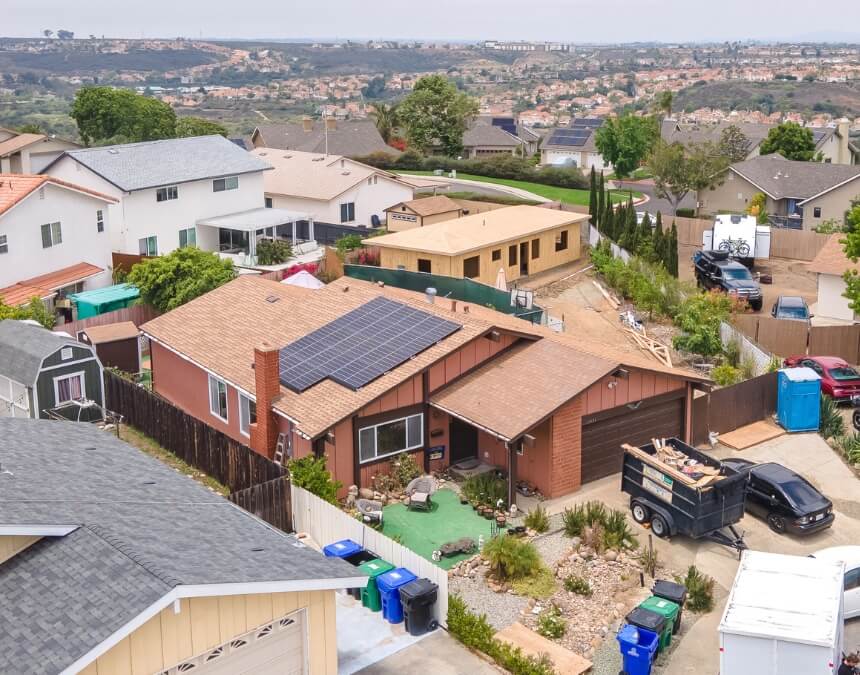
Grid-tied solar systems are the most cost-effective for ADUs—consider battery storage to improve resilience without going fully off-grid.
How to Choose the Right Solar Vendor and Equipment for Your ADU
Selecting the right solar vendor and equipment is crucial for maximizing the benefits of solar energy in your ADU. Homeowners in San Diego have the flexibility to choose between specialized solar providers and general contractors who integrate solar within a larger construction package. Evaluating the pros and cons of each, alongside the best equipment options and maintenance considerations, ensures a successful long-term investment.
Should You Choose an Independent Solar Vendor or a General Contractor?
Choosing an independent solar vendor or using your general contractor’s integrated solar solutions each has distinct benefits and drawbacks.
Independent Solar Vendor Pros:
- Specialized expertise and dedicated solar experience.
- Access to broader product choices, tailored to specific energy needs.
- Potentially more competitive pricing due to vendor specialization and volume.
Independent Solar Vendor Cons:
- Requires separate coordination from your ADU build process, adding logistical complexity.
- Additional permitting steps and potentially longer timelines if not closely coordinated.
General Contractor-Integrated Solution Pros:
- Streamlined process, combining ADU and solar system permitting and installation.
- Single point of contact simplifying project management and reducing complexity.
- Often faster overall timelines due to synchronized planning.
General Contractor-Integrated Solution Cons:
- Potentially limited solar equipment options compared to specialized vendors.
- Costs may be bundled or less transparent, making it challenging to evaluate specific solar expenses.
Ultimately, your decision depends on your preference for project simplicity versus specialized customization.
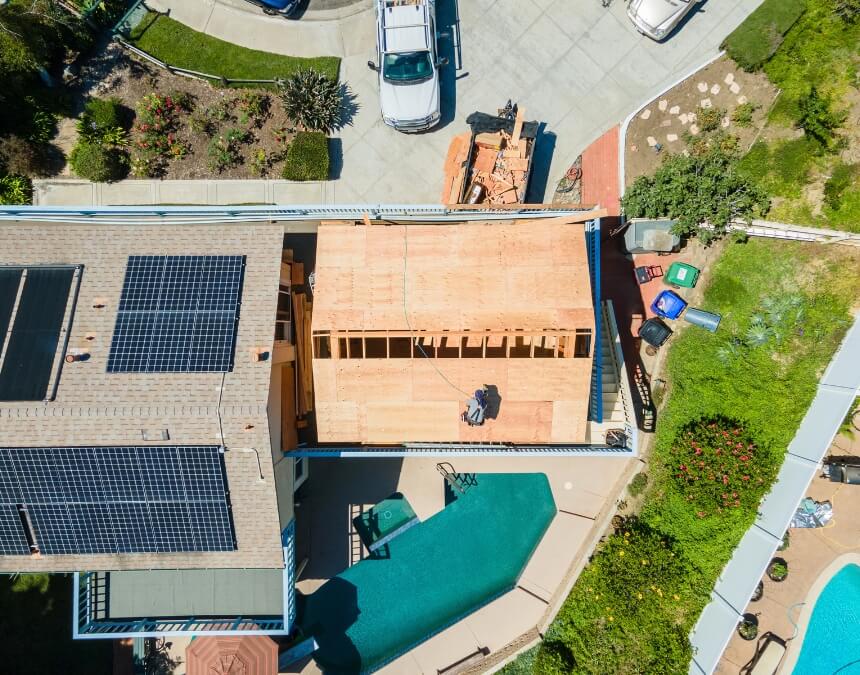
Choose a contractor who can coordinate solar with your ADU build—it streamlines permitting and ensures system compatibility.
Why Should You Integrate Battery Storage with Your Solar System?
Battery storage significantly enhances the value and reliability of your solar-powered ADU, providing crucial advantages, especially during power outages.
Key Advantages of Battery Storage:
- Energy Resilience: Maintain power during blackouts or grid interruptions, crucial for emergency preparedness.
- Energy Cost Management: Store energy when utility rates are low, and use stored power during peak pricing periods, further reducing electricity bills.
- Long-term Savings: Although initially costly, battery storage typically pays for itself over time, especially with rising energy costs.
Conducting a detailed cost-benefit analysis is advisable, but battery storage generally offers meaningful returns and increased independence from utility companies.
What Are Common Concerns About Solar and Electric Bills?
Homeowners commonly express concerns regarding the actual efficiency and savings potential of solar installations. Many misconceptions lead to confusion over expected reductions in utility bills.
Common Misconceptions and Clarifications:
- Misconception: “My electric bill won’t drop significantly after installing solar panels.”
- Reality: Properly sized solar systems drastically cut utility bills; typically, homeowners see substantial long-term reductions.
- Misconception: “Solar panels only produce meaningful energy in perfect conditions.”
- Reality: Modern solar panels are highly efficient even on cloudy days, producing significant amounts of energy year-round.
Solutions to Billing and Consumption Queries:
- Regularly monitor solar system output through integrated monitoring software.
- Conduct periodic energy audits to optimize household energy efficiency.
- Consult with solar experts or your vendor to address billing anomalies and ensure proper system performance.
How Should You Select Solar Equipment and Components?
Choosing the best solar equipment—panels, inverters, and monitoring systems—is essential for optimizing your ADU’s energy efficiency and durability.
To effectively compare options and pricing, consider using reputable platforms such as the EnergySage Solar Marketplace, which offers detailed equipment comparisons, user reviews, and competitive quotes from vetted solar vendors.
Here’s a concise comparative guide:
|
Component |
Considerations |
Recommended Brands |
|---|---|---|
|
Solar Panels |
Efficiency, warranty, aesthetic appeal |
LG, SunPower, Panasonic, REC |
|
Inverters |
Reliability, performance monitoring capability |
SolarEdge, Enphase (microinverters), SMA |
|
Monitoring Systems |
Ease of use, detailed analytics |
SolarEdge Monitoring, Enphase Enlighten, SMA Sunny Portal |
How Do You Ensure Proper Maintenance and Longevity of Your Solar Panels?
Regular maintenance and understanding of your solar system’s warranty coverage ensures optimal long-term performance, typically lasting between 25–30 years.
Recommended Maintenance Practices:
- Inspect solar panels annually for damage, debris, or dirt accumulation.
- Regularly monitor system output via integrated software to quickly detect performance issues.
- Schedule professional inspections every 3–5 years to verify electrical connections and inverter performance.
Typical Warranty Coverage:
- Most reputable solar panel manufacturers offer 25-year performance warranties, ensuring panels maintain approximately 80–90% efficiency throughout their lifespan.
- Inverter warranties generally range from 10–25 years, depending on the manufacturer and model.
- Battery storage solutions typically include warranties around 10 years, providing substantial peace of mind regarding your investment.
FAQs
Yes. Under California’s Title 24 energy code, most newly constructed, detached ADUs are required to have solar panels. Exceptions exist for ADUs converted from existing spaces (like garages), attached ADUs, manufactured ADUs, or very small ADUs (typically under ~600 sq. ft.), which may not require solar if their calculated solar size is under 1.8 kW.
High electric bills despite solar panels can occur due to increased energy usage, inefficient appliances, or the timing of electricity consumption under new net metering (NEM 3.0) policies in California. NEM 3.0 significantly reduces credits for excess electricity sent to the grid, meaning you save less unless you utilize battery storage to minimize grid reliance, especially during peak pricing hours.
The “20% rule” refers to California’s guideline allowing builders flexibility when sizing solar systems. The required solar installation can be sized at 80% (a 20% reduction) of the calculated electricity usage if battery storage or other energy-efficiency measures are included, helping homeowners meet solar mandates more cost-effectively.
The required solar system size for an ADU is calculated using California’s Title 24 energy code formula, considering your ADU’s size, local climate zone, and estimated annual electricity usage. As a general guideline, a small ADU (~600 sq. ft.) may require roughly a 1.8–2 kW system (approximately 4–6 panels), while a larger unit (~1200 sq. ft.) might need 3–4 kW (around 8–12 panels).
Conclusion
Building a solar-powered accessory dwelling unit is not only a wise financial investment—it’s also a powerful step toward sustainable ADUs and energy independence. With California’s Title 24 solar requirements shaping the future of residential construction, installing solar on your ADU helps you achieve compliance, long-term savings, and increased property value.
By carefully considering factors like system size, vendor selection, battery storage integration, and maintenance, homeowners can maximize both immediate and long-term benefits. Resources like the PVWatts Calculator and the EnergySage Solar Marketplace provide essential tools for making informed decisions.
Ultimately, embracing solar solutions for your ADU positions you to take full advantage of San Diego’s abundant sunlight, attractive financial incentives, and local support for renewable energy. It’s a decision that enhances your home’s value, reduces your environmental impact, and supports California’s ambitious clean-energy goals—making solar a clear win for homeowners today and for generations to come.

San Diego’s solar potential makes it ideal for ADUs—installing solar during construction maximizes ROI, efficiency, and compliance.

